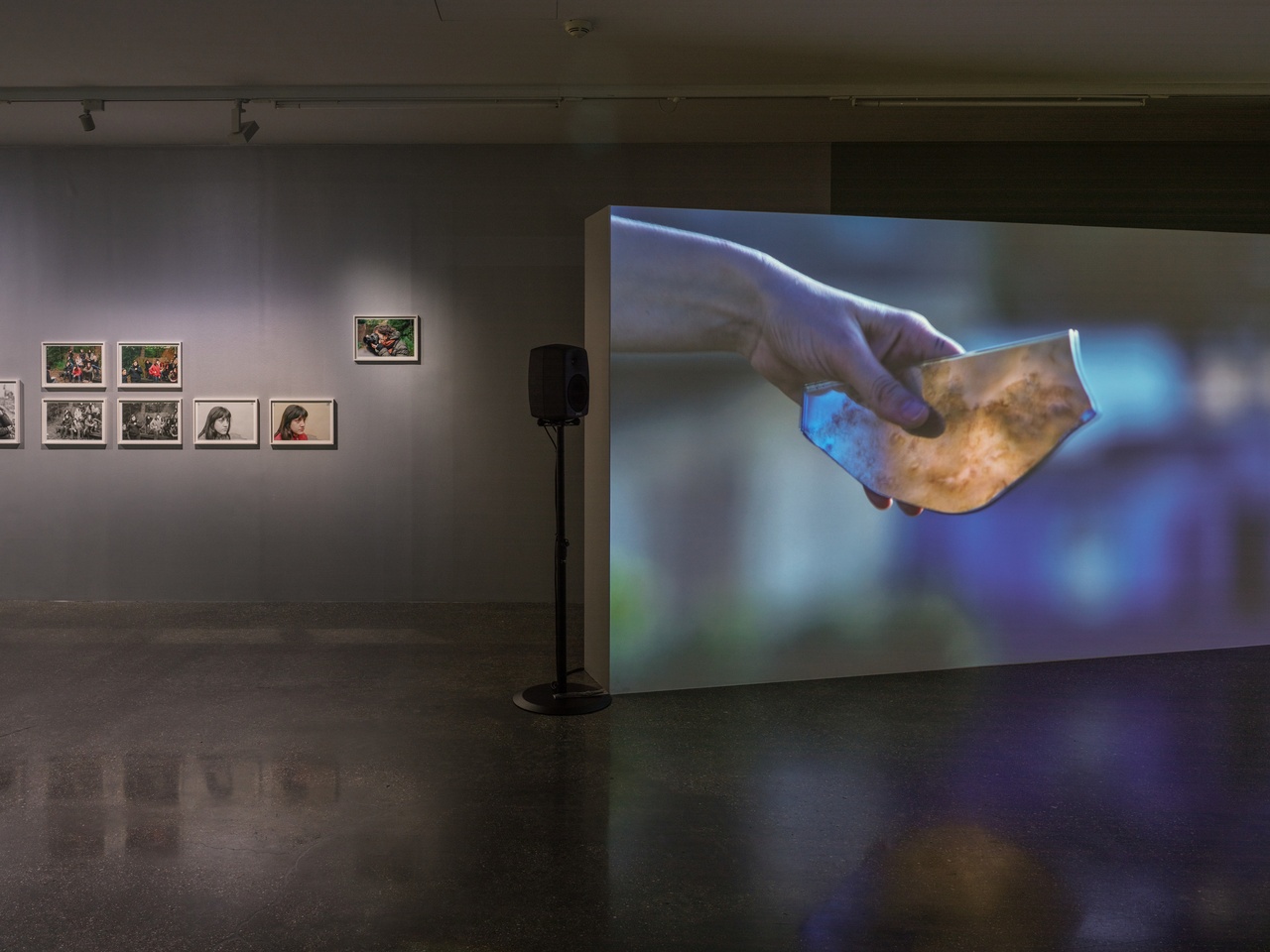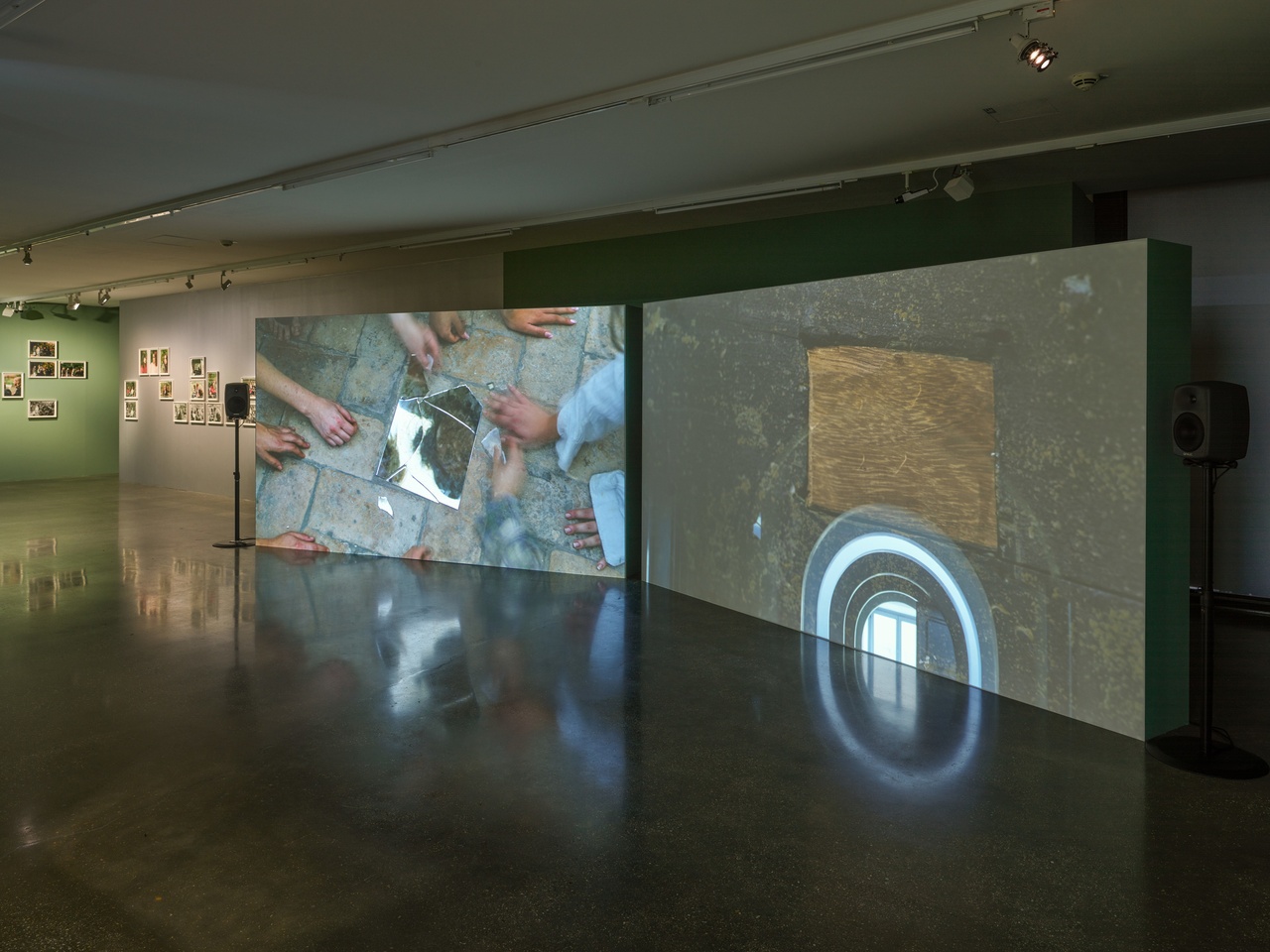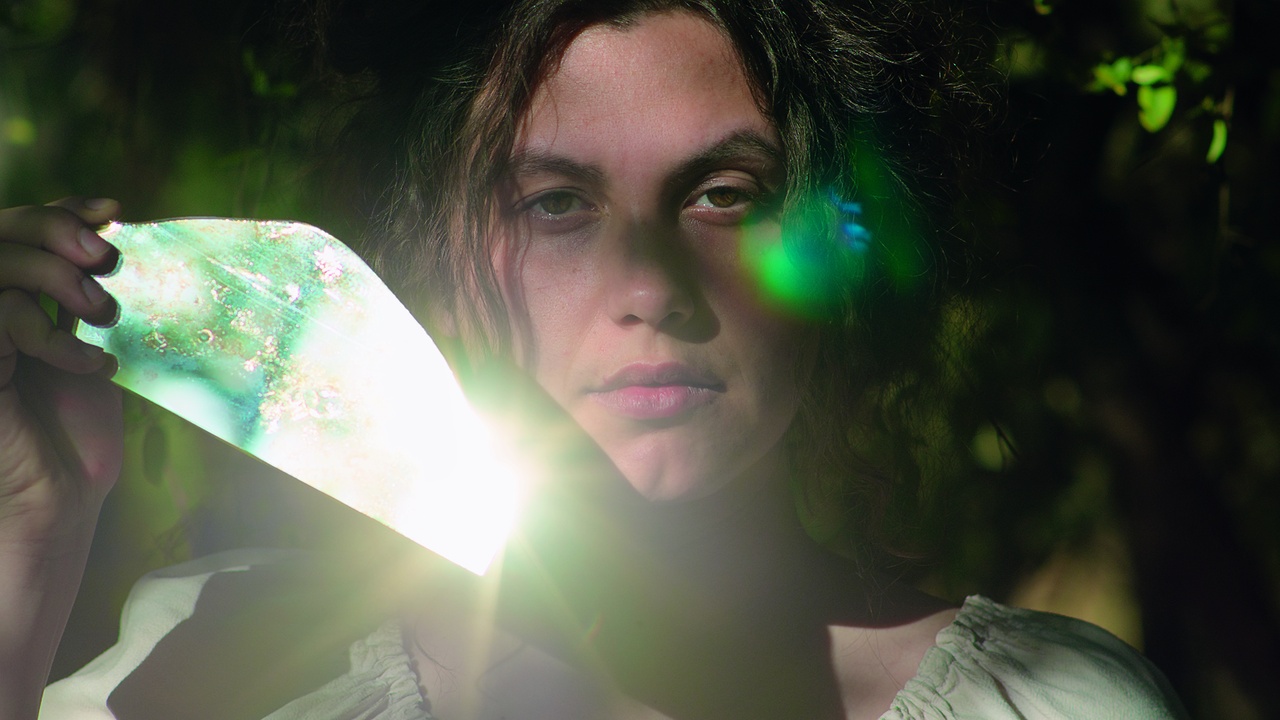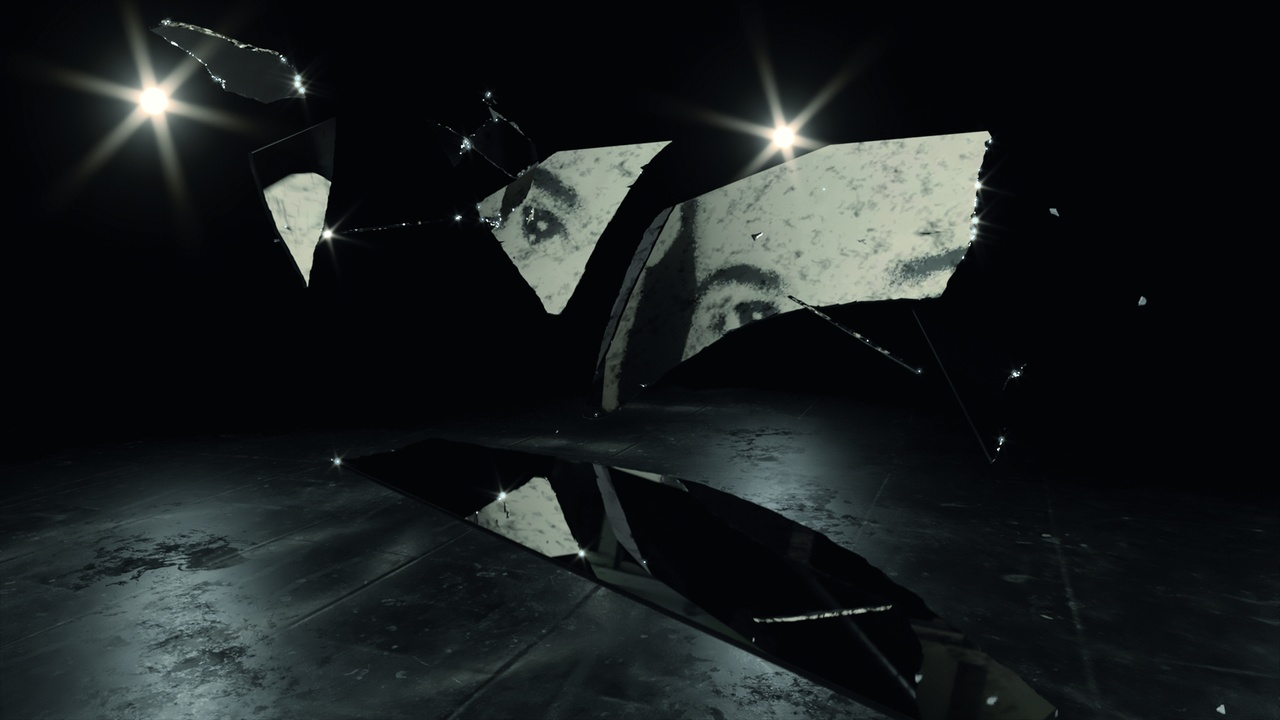“Like a pupil in the changing of light” – the poetic title of Constanze Ruhm’s latest exhibition already seems to indicate the immediate effect that the visuals, emanating from the films presented at Belvedere 21, might have on their spectators. Through these video works as well as historical objects and documents, Ruhm not only comments on and updates the feminist movements of the 1970s in Italy; she also tests a feminist way of seeing that aims to shatter patriarchal regimes of looking. Moreover, based on strategies such as archival research, photographic reenactment, and essayistic writing, the forensic narrative fabric of this exhibition addresses meta-questions of feminist historiography, as Lisa Stuckey explains. Taking the motif of the broken mirror, which features prominently in Ruhm’s films, as a starting point, Stuckey offers three theoretically and methodologically different reflections on this exhibition.
“Constanze Ruhm: Come una pupilla al variare della luce” consists of twelve exhibits and nine protagonists. Furthermore, it features four motifs (a broken mirror, an echo chamber, a self-portrait, a rehearsal) and one architectural setting (the Casa Internazionale delle Donne in Rome, a former women’s prison and today a place which assembles people and archival materials, and which was used as a film and photographic set for two of the displayed works). This listing is an attempt at providing orientation to a constellational exhibition that features widely intertwined historical, discursive, and work-immanent references. Based on strategies such as archival research, filmmaking, computer animation, photographic reenactment, essayistic writing, and arranging of historical documents and objects, the forensic narrative fabric of Constanze Ruhm’s exhibition addresses meta-questions of feminist historiography, in particular its facets of archival politics, multivocal memory, and shared artistic legacy. Curated by Claudia Slanar, the show revolves around a case study of the aspirations, infrastructures, and ambivalences of the Italian feminist group Rivolta Femminile, founded in 1970 by Carla Lonzi, Carla Accardi, and Elvira Banotti in Rome. Three glass vitrines with exhibits by Lonzi, the artist Suzanne Santoro, and the photographer Maria Grazia Chinese constitute the backbone of the exhibition’s referential apparatus, which has various connecting points to Ruhm’s two-channel video installation A Shard Is a Fragment of a Life (2023), photo series La strada (è ancora) più lunga (2021), and computer animation Dark Mirrors (Turning Brighter) (2023). The motif of the broken mirror, including the event of breaking as well as the state of brokenness is what links the various exhibits spatially and metaphorically. It will therefore be the starting point for three readings of “Come una pupilla al variare della luce,” each through a different theoretical framework.
I. The Mirror as a Dis-/Re-Orientation Device
The broken mirror used as a technical and conceptual device in the film A Shard Is a Fragment of a Life was taken as a blueprint for the dichromatic exhibition design, which builds on the idea of shards put back together. The fragmented shapes become transferred to the wall via paint. Where one shard touches another, the color changes: green is an allusion to the series Libretti Verdi (1970–98) published by Rivolta Femminile, made evident by a copy of one of the booklets displayed in the vitrine to the right; silver alludes to silver nitrate, a chemical used in photographic film. The optical devices of seeing, showing, and recording (like the pupilla, the mirror shards, the camera, the cinema) can be understood as “orientation devices” in the sense of Sara Ahmed’s Queer Phenomenology. Almost accidently, cracks on the floor of Belvedere 21, caused by the renovation of the adjacent Vienna Main Station, become turning lines of re-orientation, placing disputed or forgotten things that might have been “out of line” into a new relation to each other. Moving through the fragmentary logic of the exhibition promises a certain aesthetic experience as “[o]rientation involves aligning body and space.” Two modes of orientation can be discerned. The first concerns the update of an interrupted continuity: as a founder of Rivolta Femminile, Lonzi became interested in the 17th-century French literary movement Les Précieuses, which created a salon culture of critique before it was an established métier; although the Madames came from privileged backgrounds, they tried to escape heteronormative lifestyles and can thus be seen as proto-feminists. Herself a feminist critic, Lonzi placed her inquiry in this genealogical context, although the exhibition does not make this explicit. In “Come una pupilla al variare della luce” Ruhm acts similarly by conceptually and narratively inscribing herself into the history of Rivolta Femminile. Therefore, she uses Lonzi’s biography and texts as what she calls an “echo space” to rewrite the destiny of the mythological figure of Echo, a nymph who, for attempting to protect the promiscuous Zeus by distracting Hera with chatter, was deprived of speech and could only repeat the last few words spoken to her. An artist text published in the exhibition catalogue reveals a relevant detail: under the subheading “Echo, Echoes, Fantasy Echoes” the writing style switches from a non-mythological analytic description in regular type to a poetic narration remixing sources in italic type, as if the tilting of the letters enables this change of register. On the edge of kitsch, lines like “Echo […] disappeared, to reappear later in a dark chamber, in a dark room, in an echo chamber, which had become Echo’s chamber” are also spoken as a voice-over by Ruhm herself in A Shard Is a Fragment of a Life, following up on the aforementioned motif of the self-portrait. A broken line is drawn to Ruhm’s work from the self-reflective Les Précieuses to the consciousness-raising groups around Lonzi, where socioeconomic debates about marriage, homosexual love, or abortion were linked to art and social critique. The second mode of orientation consists of a spin-off or teaser: in displaying evidence of ongoing research, A Shard Is a Fragment of a Life is, to a certain degree, a spin-off from Ruhm’s forthcoming feature-length film on Lonzi, showing material that will not be part of the film. It also contains a reference to the Italian author and actress Goliarda Sapienza, who will be a central figure in another of Ruhm’s upcoming projects on prison histories of guilt.
The series La strada (è ancora) più lunga reenacts documentary photographs of feminist consciousness-raising group meetings in Rome, Milan, Florence, and Venice, as reproduced in the publication La strada più lunga (1976) by Maria Grazia Chinese, displayed in the glass vitrine to the right. Ruhm transferred the setting to the Casa Internazionale delle Donne for its historical as well as contemporary significance to women’s movements. Young Italian (lay) actresses and activists were cast to read aloud texts by Lonzi and discuss their relevance to transgenerational feminism on camera. The black-and-white photos in Ruhm’s series restage the historical postures of the meeting’s participants and are, according to the artist, arranged on the wall like footnotes indicating the source – a detail that only becomes apparent at second glance. The color photos, in contrast, are situated in the present moment; they contain subtle variations of the original postures as well as hints at Ruhm’s oeuvre (such as characters and props from other films), negotiating proximity and distance to heritage. Focusing on the rehearsal, the reenactment was also filmed for the eponymous two-channel video installation, shown in parallel in an outpost – the mumok exhibition “ON STAGE – All the Art World’s a Stage” (2023–24), also in Vienna, which seems conceptually and formally dependent on the show in Belvedere 21. Both the moving- and still-image works are inspired by discursive pedagogical settings, merging associations with Ruhm’s career as an artist and professor at the Academy of Fine Arts Vienna. Like Ahmed, Ruhm is “indebted to generations of feminist[s],” being and having “invested” in the study of Italian feminist movements since the 1970s. Her approach links the establishment of a feminist genealogy through biographies with disorientations in allegedly clear/straight narratives, where the mirror (reflecting a familiar face) becomes an estranged object, leading us to engage with it differently.
II. The Image That Constitutes the Gaze
Images, documents, and works by Carla Lonzi and the artists Suzanne Santoro, Stephanie Oursler, and Maria Grazia Chinese in the vitrines and on the walls are displayed as if through “an eye ‘given’ by an ‘other’ seeing” that intermingles with Ruhm’s own seeing. As an artistic strategy, this curatorial gesture of working with a borrowed gaze is further elaborated cinematically in the installation A Shard Is a Fragment of a Life. Here, protagonists (designated as ghosts in the work description on the wall) impersonate members of the consciousness-raising groups, using the glare of mirror shards to cross the filmic fourth wall, momentarily blinding the viewer. The indeterminable locality and temporality of the gaze of the other is thus translated into the dazzling effect of the mirror as an analogue special effect blending images in a different angle as if they originated from a different time. For its part, the mirror also pays homage to Suzanne Santoro’s series Black Mirrors (1976–80), from which a mixed-media work and photographs are shown vis-à-vis the installation. The notion of “Zerzeigung,” according to Dieter Mersch, implies a “‘reflexivity in showing’” as “showing itself” – here in the exhibition as fragmenting, de-showing, ex-hibiting, un-masking. For this media reflexivity to succeed, each “reference that is constitutive for scientific practice” must be erased; consequently, “Zerzeigung […] operates with a systematic […] ‘dis-placement’ and ‘dis-ruption.’” As a result of Zersplittern (splintering), the fractured mirror is thus not only a translation of an inevitable aspect of fragmented (hi)story-telling but also evidence of dis-placement for new perspectives to arise. Textual, visual, and narrative references are placed outside the video installation in the glass cabinets that provide the codes for deciphering the conceptual-associative constellation. In this sense, the cabinet to the left contains a floor plan and an elevation plan of the exhibition space, demonstrating how the fracture lines of the mirror fragments were translated into the architecture. In a historizing effect, the vitrines place a set photo, a film still, and the mirror shards from Ruhm’s recently recorded film on the same supporting structure as the artifacts, works, and biographies belonging to Rivolta Femminile. This spatio-temporal horizontalization points out the fragility of feminist legacy by simultaneously strengthening the impact factor of the quoted artists/intellectuals.
III. Adjustments Towards People and Object Biographies
“Come una pupilla al variare della luce” is conceived as a chamber for a historically only faintly audible echo that requires amplification, most strongly epitomized in the choir as basis for the film music of A Shard Is a Fragment of a Life. One could ask about the ambivalences that surfaced in the process of making an echo heard: What discomfort might members of the consciousness group have felt in relation to one another, whether in blatant conflicts or divergent approaches to social change (think, for example, of Lonzi’s proposal of “deculturazione”)? The color photographs in the series La strada (è ancora) più lunga could be seen, with Lauren Berlant, as adjustments toward the historical texts by Lonzi that are read out loud. Certain passages or trains of thought might make the reader feel inconvenienced, as inconvenience, according to Berlant, “is not only a world of other people […] – animals, things, and thoughts are inconvenient too.” The mirror shards are reminiscent of the wounds experienced by the violated women portrayed in Un album di violenza (1976), an artist book by Stephanie Oursler, displayed in the middle glass cabinet. As a dark and horrific calendar covering a whole year, Un album is composed of press clippings from the newspaper Il Paese, reporting about violence against women. Ten of the victims are photographically portrayed accompanied by short clauses that, in their omissions, imply violent results, such as “after school she used to take the train home by herself” or “in the cinema she met a guy called Carlo.” A striking soberness of the clauses correlates with the nonappearance of consequences, where “rape and […] death […] often remain incidents rather than growing into transformational events.” They remain incidents or cold cases. The same portraits are also mapped onto the shards in Ruhm’s looped animation Dark Mirrors (Turning Brighter), presented in a black box. De- and re-compositions of the broken mirror seem characteristic of repetitive violence – with brightness adverting either to an approaching death or optimistically to improvements in social justice. The work could be understood as an expression of an indeterminacy regarding sender and receiver of the echo, which eventually can only be heard in a distorted form, allowing one to gain distance from the object of affirmative-critical engagement with “facts or fates.” Breaking becomes a strategy to imagine different “ways to transform the qualities of object/scenes […] creating alternative-world workarounds subjectively and politically.”
Perhaps too subtle to grasp its accomplishment at first glance, the exhibition might seem to adhere to conventional forms, formats, and displays. However, as a reference-based constellation at the threshold of subtlety, it invites delving into the underlying curiosity-driven research that attends to ephemeral stories, images, and documents found in archival traces. Where a void would have been, speculation merges with a thorough probing of historiography.
“Constanze Ruhm: Come una pupilla al variare della luce,” Belvedere 21, Vienna, March 16–August 27, 2023.
Lisa Stuckey is a media cultural theorist and art critic. Currently she is a senior lecturer/scientist at the University of Applied Arts Vienna.
Image credit: 1.– 2. Photos Johannes Stoll / Belvedere, Vienna; 3. Director of photography Hannes Böck, © Constanze Ruhm, courtesy Charim Galerie; 4. Animation Franz Schubert, courtesy Constanze Ruhm
Notes




